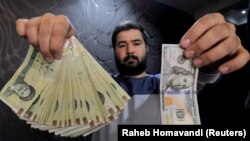Iranian authorities have vowed to enforce a single exchange rate to the U.S. dollar in a bid to stop a slide that has seen Iran's rial currency fall by more than one-third in seven months.
First Vice President Eshaq Jahangiri said that from April 10 on, the government will sell the dollar at a rate of 42,000 rials to all individuals and businesses who have a "legal needs."
But the nuance in his announcement is the words "legal needs" for dollars. This means dollars will be provided to those businesses that have official permission to import into Iran or other approved transactions. However, individuals and businesses who wish to convert their savings or profits into hard currency will not be able to buy unlimited dollars from official banks.
Later on April 10, Iran's Central Bank announced that holding more than 10,000 Euros or its equivalent in foreign currencies is forbidden for individuals.
This means that an acute need for hard currency will not diminish by Jahangiri's announcement. According to latest reports received from Iran, all non-governmental exchanges remain closed or idol, because no one in the private sector believes the real value of the dollar is 42,000 rials.
Reports from Tehran as of mid-day April 10 indicate that the banks have not made any dollars available at the 42,000 rial rate as promised by Jahangiri. In fact, bank and official exchange dealers are selling dollars for 50,000 rials.
Speaking late on April 9, after an emergency cabinet meeting, Jahangiri asserted that that “enemies” of Iran were behind the currency's decline.
He said the move will effectively unify Iran’s official and open market exchange rates.
Jahangiri said that trading at any other rate than 42,000 rials for a dollar will be considered "contraband" and will be dealt with "severely” by law enforcement authorities.
The move came after the rial slid to 60,000 rials against the dollar on the unregulated market on April 9, according to media reports. The U.S. currency stood at 36,000 rials in mid-September.
The slide came amid speculation that the United States would pull out of the 2015 nuclear deal between Tehran and world powers in May. The agreement provided Iran with relief from sanctions in return for curbs on its nuclear program.
Jahangiri blamed "non-economic, unjustified, and unpredictable factors" for driving the rial's collapse, saying tens of billions of dollars worth of foreign currency had flowed into Iran in recent weeks from the country’s export revenues.
“It’s natural that our enemies and opponents, especially the Americans, after the nuclear deal was agreed and after [U.S. President Donald] Trump took office, have made great efforts to try and present Iran’s economy as turbulent and try to discourage anyone from working with Iran,” Jahangiri said.
Government spokesman Mohammad Bagher Nobakht said on April 10 that Iran brings in some $95 billion a year in foreign currency, mostly from crude oil exports, while $80 billion are spent on imports.
But Iran's economic system is overburdened by inefficient state owned industries and companies, besides huge outlays for a myriad of religious institutions and covert military expenditures.
Trump has threatened to pull the United States out of the nuclear agreement and reimpose sanctions on Iran in May unless new restrictions are placed on its atomic and missile programs.
Iranian President Hassan Rouhani on April 9 warned that Washington "will regret it" if Washington violates the accord.
With reporting by Bloomberg, Reuters, and AFP





